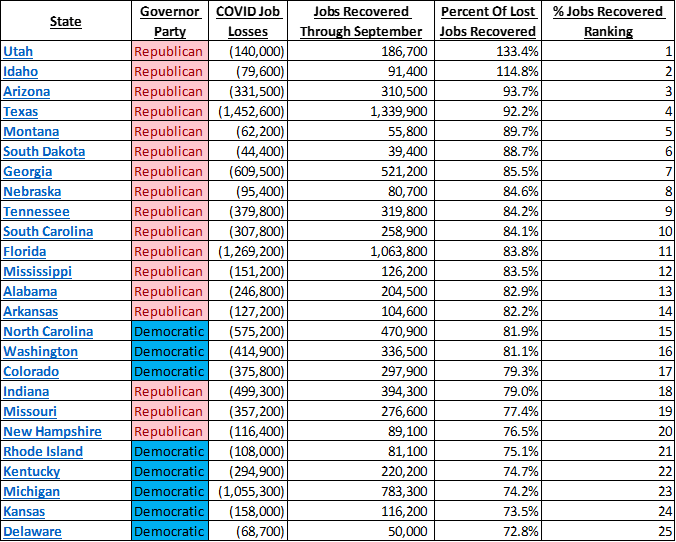Analysis: Republican-led States Lead Democrat-led States in Economic Recovery in November

States with Republican governors and legislatures are leading Americans back to work quicker than those led by Democrats, according to an analysis of the state-by-state unemployment data from the Department of Labor.
The analysis of the Labor Department’s November unemployment data from the Republican National Committee (RNC) research team uncovered that the Republican-led states continued to outperform Democrat-led states in job recovery for 17 of the top 20 states, and the lowest unemployment in 16 of the top 20 states.
“More jobs are being recovered and unemployment is lower in red states,” the RNC research team wrote.
Without interruption from a Democrat-led state, the top 13 states leading in job growth as states across the country continue to end the coronavirus restrictions as Americans get back in the states run by a Republican governor.
Looking further into the data, the RNC analysis confirmed that 17 of the top 20 states led by Republican governors are doing a better job versus those led by Democrats governors. Plus, 18 of the top 20 recovering states have Republican-controlled legislatures. Both of these are the ratio that the analysis of the October data revealed.
Republican-led states have proven to bring jobs back faster than Democrat-led states as Americans get back to work, according to new state-by-state unemployment data from the Department of Labor. https://t.co/7v95vJ0HxF
— Breitbart News (@BreitbartNews) May 24, 2021
Additionally, four Republican-led states — Utah, Idaho, Texas, and Arizona — have produced more jobs than the state had before the coronavirus pandemic started and any restrictions were put in place. Since the pandemic, Utah has had 143.6 percent of its jobs recovered, Idaho has had 118.2 percent, Texas has had 101.9 percent, and Arizona has had 101.5 percent.
The RNC analysis also showed that 24 states that are Republican-led recovered at least two-thirds of the jobs lost during the pandemic. On average, Republican-led states have recovered 85 percent of their lost jobs since the beginning of the pandemic. In comparison, only 73 percent of the Democrat-led states have recovered their lost jobs since the beginning of the pandemic.
“Republican leadership delivers. While Joe Biden and Democrats continue to lie to the American people about their failed Build Back Broke agenda, Republican-led states continue to lead our economic recovery by getting Americans back to work,” said RNC Chairman Ronna McDaniel on the analysis of the Labor Department’s November data.
Data from the U.S. Department of Labor, colorized analysis by the Republican National Committee.
Moreover, according to the RNC analysis, without interruption from a Democrat-led state, the nine states with the lowest unemployment rates are Republican-led.
Additionally, 16 of the top 20 states with the lowest unemployment rates are led by Republicans governors, with 17 having Republican-controlled legislatures. Seven of the eight states with the highest unemployment numbers in November — six percent or higher — are led by Democrat governors.
The states with Democrat governors in order of unemployment percentages are Connecticut (6 percent), Hawaii (6 percent), New Mexico (6.2 percent), New Jersey (6.6 percent), New York (6.6 percent), Nevada (6.8 percent), and California (6.9 percent).
Overall, Democrat-led states have an average unemployment rate of 1.4 percentage points higher than the Republican-led states. The 27 states with the lowest unemployment rates are run by a Republican governor, averaging 3.7 percent. In contrast to the Democrat-led states, which have an average unemployment rate of 5.1 percent.
Nine Republican-led states had lower unemployment rates in November than when the coronavirus pandemic began, according to the RNC analysis. Those states, starting from lowest unemployment are Nebraska (1.8 percent), Utah (2.1 percent), Oklahoma (2.5 percent), Idaho (2.6 percent), Vermont (2.6 percent), New Hampshire (2.7 percent), South Dakota (2.7 percent), Georgia (2.8 percent), and Montana (2.8 percent).
Data from the U.S. Department of Labor, colorized analysis by the Republican National Committee.
“Americans see through Biden’s empty promises for what they are – a massive tax and spend spree that will raise taxes on the middle class and continue to send prices skyrocketing,” McDaniel added. “In 2022, voters will reject Democrats’ failed agenda and vote for Republican leadership up and down the ballot.”
All of this is happening while President Joseph Robinette Biden, Jr. and the Democrats have rammed bills through Congress that hurt Americans, in addition to inflation rising and hurting the everyday Americans.
The Democrats passed the disastrous $1.2 trillion, 2,702-page so-called bipartisan infrastructure bill earlier this year — which Biden signed into law — and passed the $1.75 trillion Build Back Better Act (BBB) in the House.
However, while the BBB was considered to be the “marquee legislation” to Biden’s legislation agenda and would ultimately increase taxes on the middle class, expand and prolong the effects of inflation, and add hundreds of billions of dollars to the U.S. deficit, was effectively killed by Sen. Joe Manchin (D-WV). The senator on Sunday said, “I cannot vote to continue with this piece of legislation.”
BIDEN DISASTER: The U.S. economy only added 194,000 jobs in September, Labor Department reported Friday. https://t.co/w5sbHW1t6W
— Breitbart News (@BreitbartNews) October 8, 2021
Nonetheless, inflation has still hit the highest level in nearly 40 years. “US consumer prices rose last month at a rate not seen in nearly 40 years… underscoring how inflation threatens the world’s largest economy and President Joe Biden’s public support,” AFP reported.
Further, a recent University of Pennsylvania’s Wharton School budget model showed that inflation would cost families an additional $3,500 this year due to the consumption from 2019 and 2020, impacting low-income families the hardest. “Lower-income groups spent relatively more on food, energy, and shelter, while higher-income groups spent relatively more on other commodities and services,” the study states.





No comments:
Post a Comment